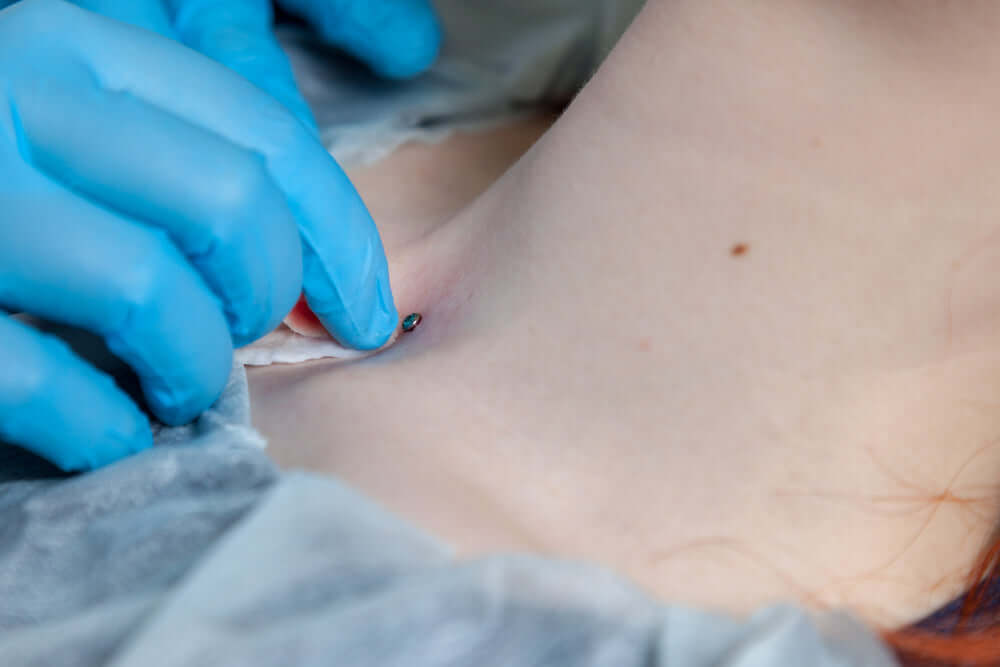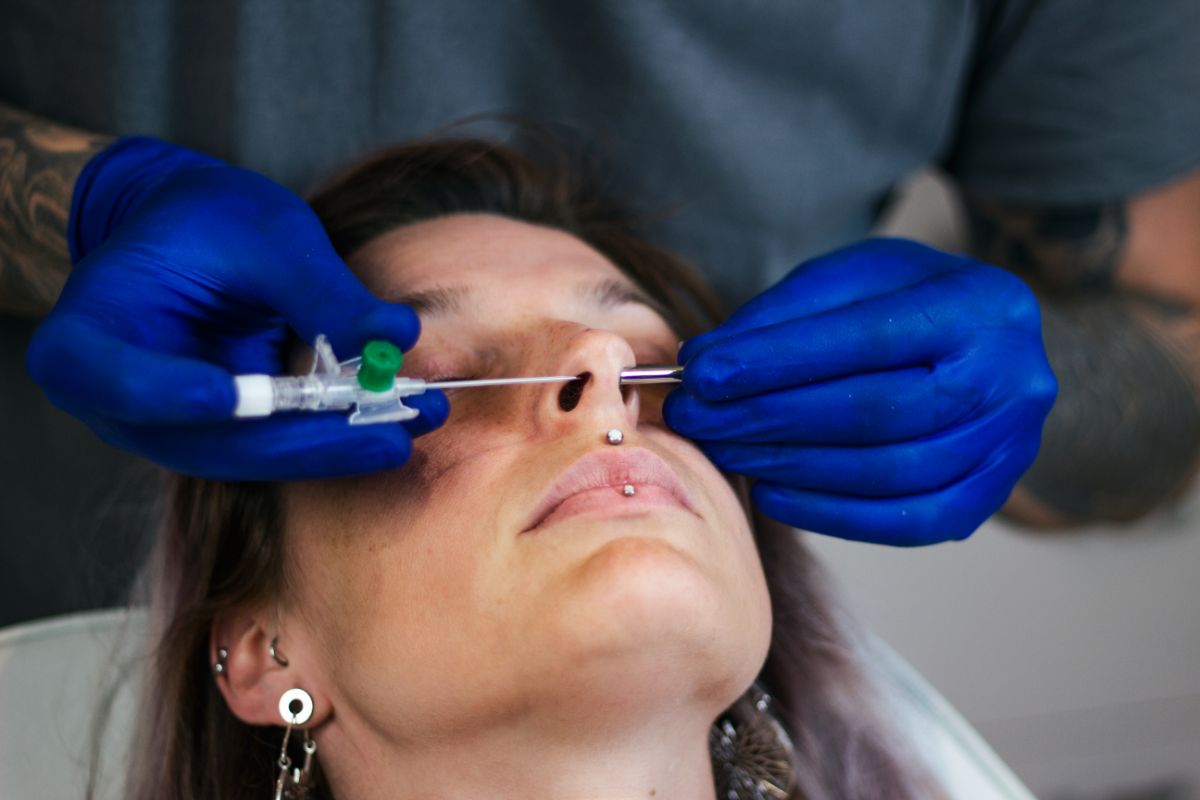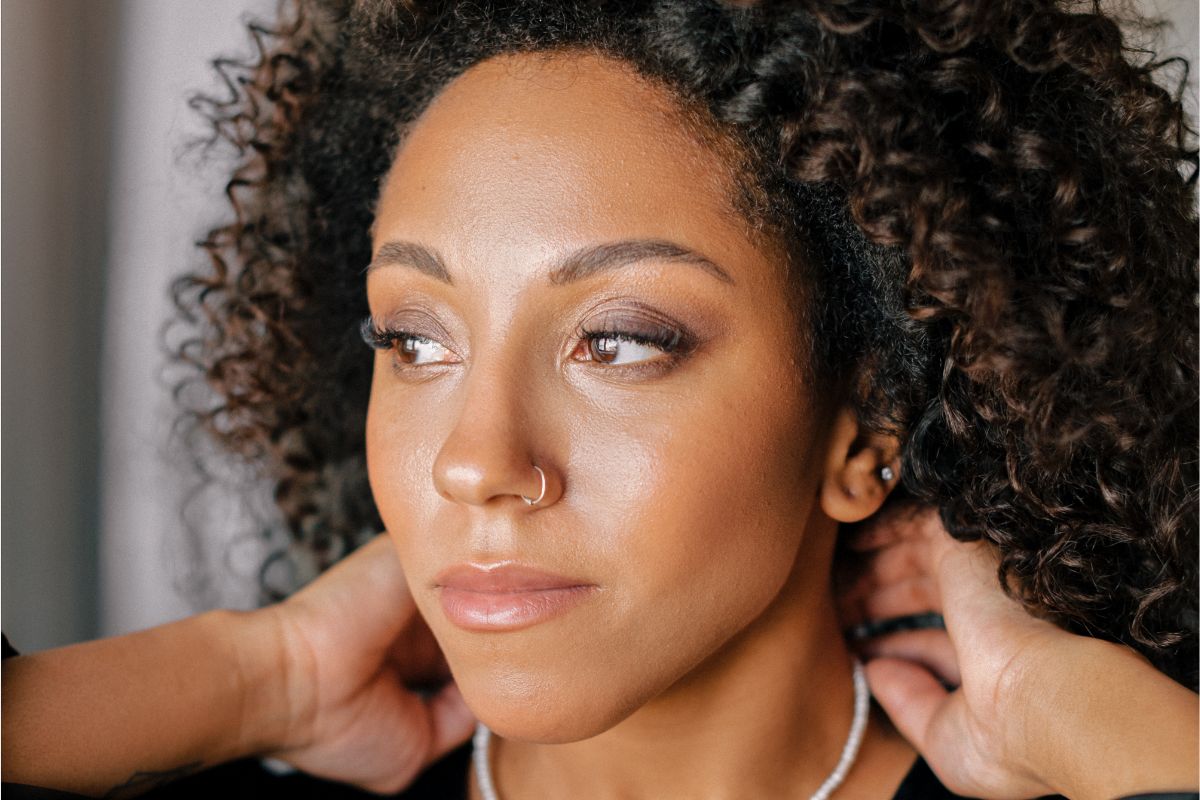Unlike a lot of other piercings, dermal piercings aren’t in one particular place. A dermal piercing is any piercing that is single entry. This means that it doesn’t have an entry or exit hole. This is different from something like an earlobe piercing, where the piercing goes in one side and comes out the other.
Instead, the person piercing you will pierce one piece of skin. This will act as an “anchor” for the piercing. Otherwise, it will simply fall out. The anchor is a small piece of metal that is around 6mm or 7mm long. And very thin.
The anchor sits below the skin. And the piercing is slotted into this anchor. A dermal piercing will be placed on a part of the body that is near bone. Or is just too thick, large, or dangerous to place a needle entirely through.

This can be the neck, cheekbone, or temple. These are areas that, unlike a nostril or earlobe, cannot be completely pierced. These piercings give the appearance that they have just been placed inside the skin. But the anchor is holding them in place.
Do Dermals hurt more than piercings?
Some people do say that dermals hurt more than other piercings. This is mainly because of the anchor. The process can also take a little longer than a standard entry and exit piercing. And the skin will generally be thicker.
But, this does depend on your pain tolerance and whether you have had piercings before. It also depends on where you will have the piercing. Generally, somewhere like the temple or cheekbone will be more painful than the neck or arm. This is because the face is more sensitive.
If you have had piercings before, then you will likely know how much they hurt. Dermals, as they only go through skin, shouldn’t really hurt more than a piercing going through cartilage.
But, the anchor can cause more pain. And the area where you are being pierced might have more nerve endings than others.
How are Dermals removed?
Most piercings can be removed simply by simply taking the stud apart. This isn’t the case with dermal piercings. And, again, this is due to the anchor.
The person removing your dermal will first prep the area with surgical cleaning products. Then they will remove the jewel or stud. Next, they will need to remove the anchor. This will usually require the use of a scalpel to cut the piercing open. But this is a tiny cut. And it is only so the person removing it can see exactly where the anchor is.
The shape of the anchor means that, generally speaking, the stud or jewel will be at one end. The anchor will then extend further by around 4mm. And this will be tucked under the skin. The anchor then needs to, essentially, be unhooked from beneath the skin.
You definitely shouldn’t do this yourself. It takes an expert to know how to carefully cut out and remove the dermal. And it requires a safe and sterile environment.
Do face Dermals leave scars?
This depends on how sensitive your skin is to scars. But, generally, yes. There are ways to reduce scarring. It’s important to keep the piercing clean when it is in. And when the piercing has been removed. Otherwise, it can be prone to infection. And to scarring.
It’s also important to touch the piercing as little as possible. This might be difficult if it is on your face. But it’s important as touching it can cause it to move around. This can be painful. And can cause the piercing to become bigger. Both the hole and the space beneath where the anchor is.
You can also reduce the appearance of scars afterward. This can be with certain oils and serums that are widely available. Just make sure that the piercing has completely healed before you begin this. Otherwise, you can disrupt the healing process. And potentially cause an infection.
Why do Dermals reject?
Dermals reject because they are surface piercings. Even with the anchor, the piercing can gradually come out of the skin. This is because the body will attempt to heal the piercing. And try to push out the anchor and the jewel or stud.
Piercings are decorative and can have meaning. But they are made through wounding the body. Piercings damage the body in a specific way. And so the body will try to heal the hole. This is why it’s important to leave piercings in for a while once they have been done. And why they need turning and moving while they heal.
In something like an earlobe piercing, if the piercing isn’t regularly turned, the skin will attempt to heal around the stud. This is because the piercing has an entrance and an exit. So, try as it might, the body cannot reject it. The stud and the back essentially act as a clamp. Leaving the piercing in and turning it disrupts the healing process. So the skin around the piercing will heal. Leaving a small hole in the middle.
This is also why it’s important to regularly put studs in piercings. As they can always close up. After a certain amount of time, this does become less likely. But it is still possible.
Dermal piercings will essentially be pushed out by the body. As it is trying to eject a foreign object that shouldn’t be there. The anchor will usually delay this. And can stop it entirely. As the tissue and skin will heal around it. This is why a scalpel is needed to remove it. As the healed skin will need reopening.
How often do Dermals reject?
This mostly depends on your body. Some people will heal faster than others. It also depends on where the dermal is.
Most dermals only pierce a thin layer of skin. They look very deep. But there is only so deep a piercing can safely go. Especially if it is in a sensitive area with thin skin. For example, a temple dermal will reject more quickly than a neck dermal.
Dermal rejection is also determined by how well it is cared for. Piercings need a lot of care and attention to stop them from healing too much. As this can cause them to close up. This can cause a dermal piercing to be rejected.
Can you fix a rejected dermal?
Not really. And definitely not by yourself. If your dermal is rejecting, go and see your piercer. They might be able to stop it. Or they might tell you to allow it to come out. And then repierce it for you when the skin has healed.
If your dermal is regularly rejecting, then you might have to accept that this piercing isn’t for you. It can be frustrating to have it repierced every few months. Not to mention expensive.
How long does a dermal take to heal?
Dermals generally take around three months to heal. This will vary depending on where they are on the body, the size of the piercing, and how quickly your body heals.
But you shouldn’t change the stud or jewel before it has been three months. Follow the care instructions very carefully. Otherwise, you risk the piercing becoming infected. This can mean it has to be removed. Or it can mean that it will take even longer to heal.
So make sure to take good care of it. And don’t remove it until at least three months later. If it begins to reject before this time, go see your piercer.





